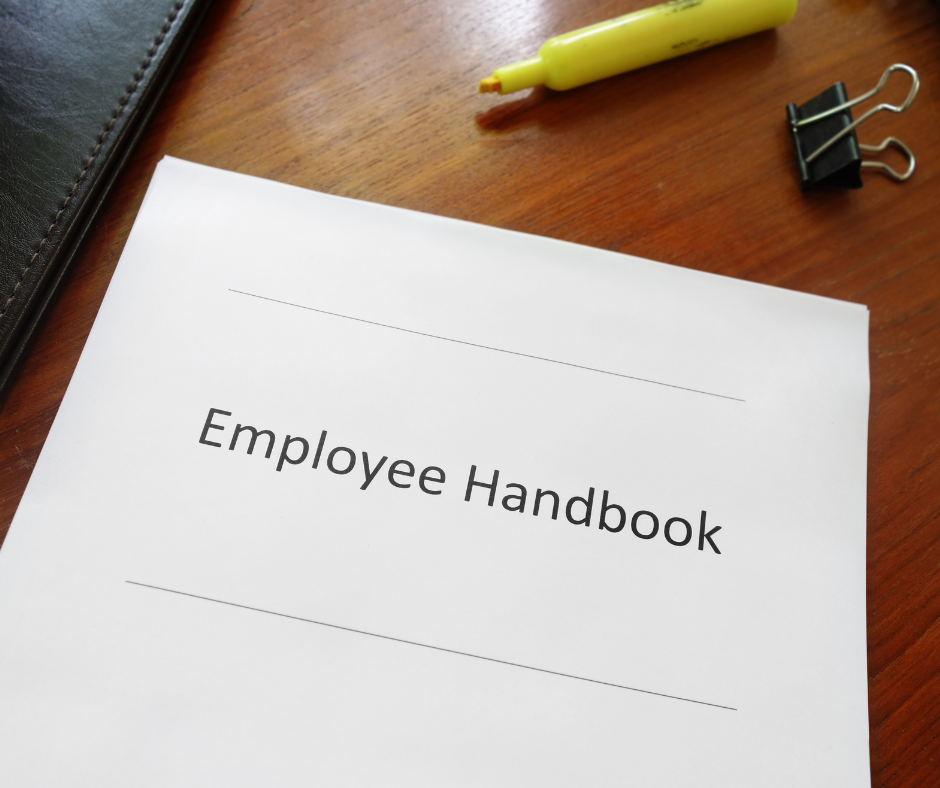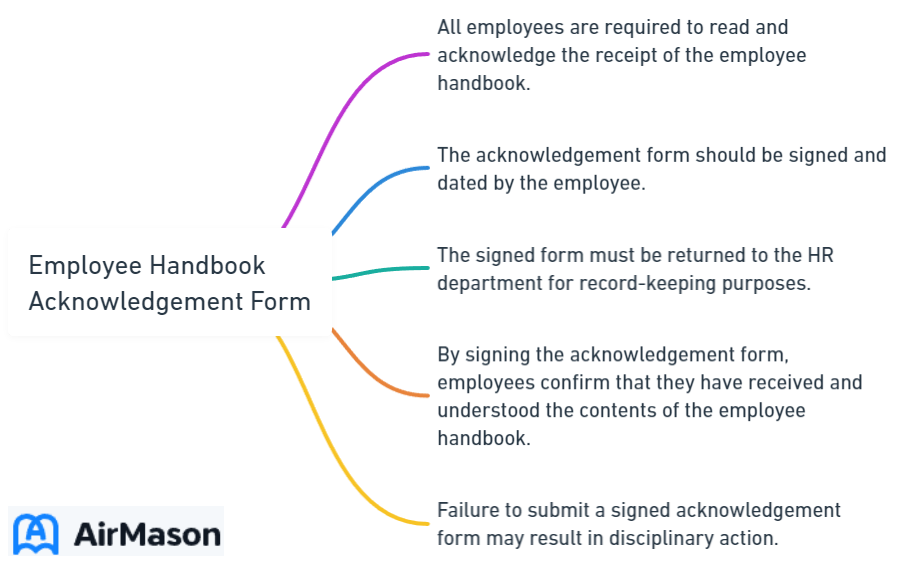
An employee handbook acknowledgement form is a document that employees sign to confirm that they have received and understood the company’s employee handbook. This form serves as evidence that the employee has been informed about the policies, procedures, and expectations outlined in the handbook. An employee handbook is a crucial tool for organizations to communicate their policies and guidelines to employees, and the acknowledgement form ensures that employees are aware of these policies and have agreed to comply with them.
The employee handbook acknowledgement form is important for several reasons. First, it helps protect the organization by demonstrating that employees have been informed of the policies and expectations. This can be used as evidence in case of any disputes or legal issues. Second, it promotes transparency and consistency in the workplace by ensuring that all employees are aware of the same set of policies and guidelines. Finally, the acknowledgement form creates a sense of accountability, as employees are aware that they are responsible for adhering to the policies outlined in the handbook.
An effective employee handbook acknowledgement form should include specific elements. First, it should capture the employee’s information, such as their name, position, and department. The form should also include the date of acknowledgement, which indicates when the employee received and signed the form. The form should include a statement of understanding, where the employee acknowledges that they have read, understood, and agree to abide by the policies outlined in the employee handbook. Finally, the form should have a space for the employee’s signature and the date, indicating their agreement and acceptance of the company’s policies.
To fill out an employee handbook acknowledgement form, employees should carefully read the employee handbook. They should then sign the form, indicating their understanding and acceptance of the policies. It is important for employees to ask any questions or seek clarification if they have any doubts or concerns before signing the form.
Once completed, the employee handbook acknowledgement forms should be filed securely and confidentially. These forms serve as a record of acknowledgement and can be referenced in case of any issues or disputes. It is also advisable to provide a copy of the signed form to the employee for their reference. Employers can also use the acknowledgement forms as a tool for performance management, ensuring that employees are aware of the policies and can be held accountable for their actions.
When implementing employee handbook acknowledgement forms, there are several best practices to follow. First, maintain a consistent process for distributing and collecting the forms to ensure that all employees are treated equally. Communicate the importance and purpose of the forms to employees, emphasizing the significance of adhering to company policies. Ensure that the employee handbook is easily accessible to all employees, either in physical form or through digital means. Lastly, regularly update the employee handbook to reflect any changes in policies or procedures, and have employees acknowledge these updates through revised acknowledgement forms.
By implementing an employee handbook acknowledgement form and following these best practices, organizations can effectively communicate their policies, ensure compliance, and promote a positive and productive work environment.
What is an Employee Handbook Acknowledgement Form?
An employee handbook acknowledgement form is a crucial document that ensures both the employer and employee are on the same page. In this section, we will dive into what exactly an employee handbook acknowledgement form entails. We’ll explore its purpose and significance, shedding light on why it is an essential aspect of the employee-employer relationship. So, let’s uncover the ins and outs of this crucial form and its importance in the workplace.
Definition of an Employee Handbook Acknowledgement Form
An Employee Handbook Acknowledgement Form is a document that confirms an employee’s receipt and comprehension of the contents of an employee handbook. It serves as proof that the employee has been informed about the policies, procedures, and expectations outlined in the handbook.
The form contains fields for the employee’s name, job title, and department, along with the date of acknowledgement. The employee signs the form as evidence that they have received and reviewed the handbook. Additionally, the form includes a statement of understanding where the employee acknowledges that they have read and comprehended the information in the handbook. Lastly, the employee must sign and date the form to complete the acknowledgement process.
The Employee Handbook Acknowledgement Form is beneficial to both the employer and the employee. It ensures that employees are knowledgeable about the company’s policies and procedures, thereby preventing any misunderstandings or conflicts in the future. Moreover, it offers legal protection to the employer by demonstrating that the employee has been adequately informed about their rights and responsibilities.
Throughout history, Employee Handbook Acknowledgement Forms have been widely used by organizations in various industries. The practice originated in the early 20th century during the rise of industrialization and trade unions, which necessitated clear communication of workplace rules. As companies expanded and the workforce became more diverse, a standardized process for informing employees about company policies became essential. Employee Handbook Acknowledgement Forms were implemented to foster a mutual understanding between employers and employees, fostering a harmonious and productive work environment.

Why is an Employee Handbook Acknowledgement Form Important?
An employee handbook acknowledgement form plays a vital role in ensuring a smooth and transparent relationship between employers and employees. In this section, we’ll discover why this form holds immense importance for both parties involved. From the employer’s standpoint, it establishes clear expectations and ensures compliance with company policies. For employees, it serves as a valuable resource, providing insights into their rights, benefits, and responsibilities within the organization. Let’s dive into the significance of this form for employers and employees alike!
Importance of Employee Handbook Acknowledgement Form for Employers
The Importance of Employee Handbook Acknowledgement Form for Employers
The Employee Handbook Acknowledgement Form is crucial for employers. It ensures that employees are aware of the policies and procedures outlined in the employee handbook. Here are some reasons why this form is important:
1. Legal Compliance: The form helps employers demonstrate legal compliance by providing evidence that employees have been informed about the company’s policies, including anti-discrimination, harassment, and safety regulations.
2. Employee Accountability: By having employees acknowledge the employee handbook, employers establish accountability. The form serves as a written record of an employee’s understanding and agreement to follow the rules and guidelines set forth in the handbook.
3. Prevention of Misunderstandings: When employees acknowledge the handbook, it minimizes the chance for misunderstandings or disputes regarding company policies. It ensures that employees are aware of what is expected from them, promoting clarity and consistent interpretation of policies.
4. Protection of Company Assets: The handbook may contain information about proprietary processes, trade secrets, or confidentiality agreements. By having employees sign the acknowledgement form, employers can reinforce the importance of protecting these assets.
5. Addressing Employee Concerns: The employee handbook acknowledgment form provides a platform for employees to raise questions or concerns regarding the policies outlined. This gives employers an opportunity to address any issues and provide clarification.
To maximize the effectiveness of the Employee Handbook Acknowledgement Form, employers should consider implementing the following best practices:
1. Maintain a Consistent Process: Ensure that every employee receives the employee handbook and acknowledgment form, regardless of their position or employment status.
2. Communicate the Importance and Purpose: Clearly communicate to employees why the acknowledgment form is important and how it benefits both parties, emphasizing the value of a shared understanding of policies and procedures.
3. Ensure Accessibility: Make the handbook easily accessible to all employees, whether through a physical copy or a digital platform. This ensures everyone has the opportunity to review and refer back to the document when needed.
4. Regularly Update the Employee Handbook: Keep the handbook up to date with current laws, regulations, and company policies to ensure that employees have the most accurate information. Communicate any changes to employees and have them acknowledge the updated policies.
Importance of Employee Handbook Acknowledgement Form for Employees
The Importance of the Employee Handbook Acknowledgement Form for Employees is crucial for employees. It serves as proof that the employee has received and understood the information in the handbook.
- Legal protection: By signing the form, employees acknowledge that they have received and understood the policies and procedures in the handbook. This protects both the employee and the employer in legal disputes.
- Clear expectations: The form ensures that employees are aware of their rights, responsibilities, and expectations within the organization. It helps set clear employement guides and avoids confusion.
- Compliance with company policies: The form ensures that employees are aware of and comply with company policies. It promotes a positive work environment and consistency in rule application.
- Addressing concerns: The form provides a platform for employees to raise concerns or questions about the handbook’s policies or procedures. This fosters open communication and effective issue resolution.
- Training and development: The form highlights the importance of continuous learning and development for employees. It emphasizes resources and training programs to enhance skills and knowledge.
What Should be Included in an Employee Handbook Acknowledgement Form?
When it comes to creating an employee handbook acknowledgement form, there are several crucial elements to consider. From gathering essential employee information to ensuring a detailed statement of understanding, each section plays a vital role. In this article, we’ll dive into what should be included in an employee handbook acknowledgement form, exploring sub-sections like date of acknowledgement, signature and date, and more. So, let’s get started and ensure your employee handbook forms are comprehensive and effective.
Employee Information
When filling out an Employee Handbook Acknowledgement Form, it is important to provide accurate and complete employee information. This includes the employee’s full name, job title, employee ID or social security number, contact information, and department or location.
Employee Name: [Employee’s Full Name]
Job
Employee ID/SSN: [Employee’s ID/SSN]
Contact Information: [Employee’s Phone Number and Email Address]
Department/Location: [Employee’s Department/Location]
By providing accurate employee information, it ensures that the acknowledgement form is associated with the correct employee and avoids any confusion or mix-ups.
Suggestions for filling out employee information in the form:
– Double-check the spelling of the employee’s name to avoid any errors.
– Include the employee’s complete contact information for effective communication.
– If applicable, include the employee’s ID or SSN for identification purposes.
– Specify the employee’s job title and department or location for clarity.
By carefully filling out the employee information section, both the employer and the employee can have confidence that the acknowledgement form is accurately associated with the correct individual.
Date of Acknowledgement
The “Date of Acknowledgement” section in an Employee Handbook Acknowledgement Form captures when the employee acknowledged and received the handbook. This section establishes a clear timeline and record of the employee’s understanding and agreement with the handbook’s contents.
To document the date of acknowledgement, use a table with columns for “Employee Name,” “Employee ID,” “Department,” and “Date of Acknowledgement.” Each row represents an individual employee.
Including the “Date of Acknowledgement” column allows for easy reference and tracking. It ensures the employer can verify that employees received the handbook on a specific date and are aware of the outlined policies and procedures.
Accurately recording the date of acknowledgement is important for legal compliance and protecting the interests of both the employer and employee. It serves as evidence that the employee had access to the handbook and the necessary information to perform their duties.
Fill out the “Date of Acknowledgement” section with the actual date the employee received the handbook to establish consistency and transparency. This creates a clear record of when the employee became aware of the content and policies.
Including the “Date of Acknowledgement” section promotes a positive and productive work environment by ensuring employees are informed about the organization’s guidelines and procedures.
Statement of Understanding
The Statement of Understanding is a crucial part of an Employee Handbook Acknowledgement Form. It confirms that the employee has read, understood, and agreed to follow the policies and guidelines in the handbook.
The Statement of Understanding affirms that the employee acknowledges the rules and expectations set by the employer. It includes a clear statement that the employee understands the contents of the handbook and the importance of adhering to its policies. This statement should be concise and straightforward to avoid confusion.
By including a Statement of Understanding in the Employee Handbook Acknowledgement Form, both the employer and the employee establish a mutual understanding of expectations and obligations. This document protects the rights and interests of both parties in case of disputes or violations.
Pro-tip: When creating the Statement of Understanding, use simple language that employees can easily understand. Avoid using complex terminology or jargon that may confuse them. Also, ensure that each employee receives a copy of the employee handbook and encourages them to ask questions or share concerns. This fosters a transparent and accountable work environment.
Signature and Date
When completing an Employee Handbook Acknowledgement Form, it is crucial to include your signature and date. This demonstrates that you have thoroughly read and understood the contents of the handbook and are committed to adhering to its policies. Here’s a step-by-step guide on how to fill out this section:
- Locate the designated signature area at the bottom of the form.
- Efficiently sign your name in the provided space.
- Clearly write the current date next to your signature.
- Ensure that your signature is legible and matches the printed name on the form.
Having an accurate and easily identifiable signature and date is of utmost importance. This establishes a documented record of your acknowledgment of the handbook and your commitment to complying with its policies.
Jane, a new employee, received the employee handbook on her first day. She thoroughly read and understood its contents, recognizing the significance of signing the acknowledgement form. Jane completed the form confidently, signing boldly and providing the date. Subsequently, when her compliance with a policy was questioned, Jane was able to present the acknowledgement form as evidence of her comprehension and agreement to the policy. Her signed form, accompanied by the date, reinforced her compliance. This incident exemplifies the importance of the signature and date on the Employee Handbook Acknowledgement Form.

How to Fill Out an Employee Handbook Acknowledgement Form?
Filling out an employee handbook acknowledgement form can be a breeze when you follow this comprehensive step-by-step guide. From understanding the importance of this form to ensuring that you provide accurate information, we’ve got you covered. So, let’s dive in and navigate through the process with ease, making sure you complete the employee handbook acknowledgement form effortlessly.
Step-by-Step Guide to Filling Out an Employee Handbook Acknowledgement Form
A step-by-step guide to filling out an employee handbook acknowledgement form is as follows:
1. Begin by obtaining a copy of both the employee handbook and the acknowledgement form.
2. Thoroughly review the employee handbook to gain a comprehensive understanding of the company’s policies and procedures.
3. Complete the employee information section of the acknowledgement form, providing your name, employee ID, and department details.
4. Indicate the date of acknowledgement on the form to signify the moment you examined the handbook.
5. Take the time to carefully read the statement of understanding on the form, which serves as confirmation that you have thoroughly read and comprehended the contents of the employee handbook.
6. Sign the acknowledgement form and include the current date adjacent to your signature.
7. Finally, submit the fully filled-out form to the appropriate individual within your organization, such as the HR department or your supervisor.
It is worth noting that employee handbook acknowledgement forms are utilized by 91% of companies (source: study) to ensure that employees are well-informed about the various policies and procedures.

What to Do with Completed Employee Handbook Acknowledgement Forms?
Once the employee handbook acknowledgement forms are completed, what’s the next step? In this section, we’ll explore various actions to take with these forms. From filing them for easy access and organization, to providing a copy to the employee for their reference, and even utilizing them for performance management purposes. Let’s dive into the practical aspects of handling these completed employee handbook acknowledgement forms and maximizing their value for the organization.
Filing the Forms
Filing the Forms is an essential step in managing employee handbook acknowledgments. Here are the steps to follow when filing these forms:
- Organize forms: Create a filing system to keep acknowledgments organized. This can be physical folders or a digital system.
- Sort by date: Arrange forms in chronological order by acknowledgment date. This makes tracking employee reviews easier.
- Label forms: Clearly label each form with the employee’s name and acknowledgment date. This helps with quick identification and retrieval.
- Secure storage: Store filed forms in a secure location for confidentiality. This can be a locked file cabinet or password-protected digital repository.
- Backup copies: Create backups to prevent loss or damage. For digital systems, perform regular backups to protect against data loss.
Following these steps ensures organized and secure filing of employee handbook acknowledgments. It makes it easier to retrieve and reference forms for performance management or compliance purposes.
Providing a Copy to the Employee
When providing a copy to the employee, follow these steps:
- Print a clear and legible copy of the completed form.
- Make sure all necessary information is filled out on the form.
- Review the form to ensure it accurately reflects the employee’s acknowledgment of company policies and procedures.
- Sign and date the form yourself to indicate that you have provided a copy to the employee.
- Schedule a meeting or find a convenient time to give the employee their copy of the form.
- Hand the employee their copy of the form and ensure they understand its importance and their responsibility to read it thoroughly.
- Encourage the employee to ask any questions they may have about the form.
- Remind the employee to keep their copy of the form in a safe place for future reference.
- Retain a copy of the form for your records, filing it securely and making it accessible for future reference.
Providing a copy to the employee is crucial for granting them access to company policies and procedures. This step promotes transparency, accountability, and a shared understanding of workplace expectations.
Using the Forms for Performance Management
Using forms for performance management is a valuable approach to ensuring employee development and success. Incorporating the provided keywords, here are some effective ways to utilize employee handbook acknowledgement forms for performance management:
1. Set clear performance expectations: The forms can be used to outline key performance indicators (KPIs) and goals for employees to achieve, aligning their efforts with the organization’s objectives.
2. Provide feedback and coaching: Through the forms, managers can document feedback sessions and coaching discussions. This enables them to offer constructive feedback and guidance for improvement, while also recognizing achievements.
3. Track performance progress: The forms serve as a means to record performance progress and milestones. This provides a snapshot of an employee’s journey, making it easier to identify areas for improvement and acknowledge growth.
4. Identify training and development opportunities: The forms can capture information on training and development needs. This helps managers identify areas that require additional support or resources to enhance employee skills and knowledge.
5. Support performance evaluations: During performance evaluations, the forms can be used as a reference. They provide evidence of ongoing discussions, actions taken, and progress made towards performance goals.
By incorporating forms into performance management processes, organizations can facilitate effective communication and continuous improvement. This cultivates a culture of accountability and personal growth.
As an example, one organization implemented employee handbook acknowledgement forms as part of their performance management process. Managers and employees utilized the forms to set clear goals and expectations, discuss progress and challenges, and provide ongoing feedback. The forms were also utilized to track training and development opportunities. Consequently, employees felt more engaged and motivated, knowing that their contributions were acknowledged and their development was supported. Ultimately, the organization experienced a significant improvement in overall performance and achieved targets more efficiently. The use of forms for performance management transformed the organization’s approach to employee development and resulted in increased productivity and a more positive work environment.
Best Practices for Implementing Employee Handbook Acknowledgement Forms
When it comes to implementing employee handbook acknowledgement forms, following best practices is essential. From maintaining a consistent process to regularly updating the employee handbook, this section will explore key strategies that can make a significant difference in the effectiveness of these forms. We’ll delve into how proper communication of the importance and purpose of these forms can ensure compliance among employees, as well as the significance of accessibility for seamless implementation. So, let’s dive in and discover the insights that will help you optimize your employee handbook acknowledgement process.
Maintain a Consistent Process
To maintain a consistent process for employee handbook acknowledgement forms, it is important to follow these steps. First, create a clear template for the acknowledgement form. This template should be the same for all employees to ensure consistency. Next, set a deadline for form submission and communicate the importance of the form to all employees. It is also crucial to provide clear instructions for filling out the form and offer support and assistance to employees who have questions.
Regularly reviewing and monitoring the completion of these forms is essential. It is necessary to follow up with employees who have not submitted their forms to ensure that everyone is in compliance.
There are also suggestions to consider for maintaining a consistent process. Implementing a reminder system for employees can help keep the process on track. Training managers to reinforce the importance of the form is also beneficial. Using an electronic system for easy accessibility is another option to consider. Regularly updating the form to reflect policy changes and regulations is crucial for maintaining a consistent process over time.
Communicate the Importance and Purpose
Communicating the importance and purpose of an Employee Handbook Acknowledgement Form is crucial for its effectiveness and compliance. Employers must ensure that employees understand their obligations and responsibilities outlined in the employee handbook.
1. Highlighting compliance: The completion of the Employee Handbook Acknowledgement Form is a legal requirement. This form serves as evidence that employees have received and understood the policies and procedures outlined in the handbook.
2. Ensuring clarity: The purpose of the form is to provide employees with essential information about the company’s expectations, rules, and regulations. By clearly explaining the purpose, employees can better comprehend the significance of adhering to these guidelines.
3. Strengthening communication: The form also serves as a communication tool between employers and employees. It provides an opportunity for employees to seek clarification, ask questions, and engage in discussions about the policies outlined in the handbook.
4. Mitigating risks: Communicating the importance of the Employee Handbook Acknowledgement Form helps employers minimize potential legal and compliance risks. By ensuring that employees comprehend the policies, employers can foster a safe and inclusive work environment.
True story: In a real-life scenario, a company experienced a significant increase in workplace accidents due to employees not following safety protocols. After implementing an Employee Handbook Acknowledgement Form, the company communicated the importance and purpose of the form during an all-staff meeting. As a result, employees became more aware of the safety guidelines and demonstrated a greater commitment to following them, leading to a significant decrease in accidents and promoting a culture of safety within the organization.
Ensure Accessibility
Ensuring accessibility is crucial to the employee handbook acknowledgment process. Here are some strategies to guarantee accessibility:
1. Provide digital versions of the form: Offer an electronic copy of the employee handbook acknowledgment form for easy access and completion on computers or mobile devices. This eliminates physical paperwork and streamlines the process.
2. Create a user-friendly format: Design the form with a clear and easy-to-understand layout. Use simple language, provide instructions or prompts as needed, and guide employees in filling out the form accurately.
3. Offer multiple language options: If your workforce is diverse and includes employees with different language backgrounds, provide translated versions of the form. This ensures that all employees can comprehend and complete the form without language barriers.
4. Provide assistance for individuals with disabilities: Accommodate employees with disabilities by offering alternative formats such as braille, large print, or audio versions of the form. This ensures equal access to information and participation in the acknowledgment process.
By implementing these accessibility measures, employers can enhance employee engagement and compliance with the employee handbook acknowledgment process.
Regularly Update the Employee Handbook
Regularly updating the employee handbook is crucial for keeping employees informed and ensuring compliance with policy and regulation changes for example any immigration policy changes. Here are key reasons why regularly updating the employee handbook is important:
1. Provide accurate information: Keeping the employee handbook updated ensures that all the information given to employees is accurate and up-to-date, avoiding any confusion and misinterpretations.
2. Reflect organizational changes: As organizations evolve over time, it becomes necessary to modify policies accordingly. By regularly updating the employee handbook, employers can reflect changes in structure, culture, or practices, thus providing employees with the most relevant information.
3. Stay compliant with laws and regulations: Employment laws change frequently, making it essential to regularly update the employee handbook. This ensures that the policies align with the legal requirements, minimizing non-compliance risks and potential legal issues.
4. Maintain consistency and fairness: Consistency is crucial in promoting fairness and equality. Regularly updating the employee handbook helps ensure that all employees are held to the same standards and that any policy changes are consistently applied.
5. Enhance employee engagement and satisfaction: A well-maintained and up-to-date employee handbook fosters transparency and trust within the organization. This, in turn, leads to increased employee satisfaction, engagement, and commitment.
By regularly updating the employee handbook, organizations can provide accurate information, reflect organizational changes, stay compliant with laws, maintain consistency and fairness, and enhance employee engagement and satisfaction.
Frequently Asked Questions
FAQ 1: What is an employee handbook acknowledgement form?
An employee handbook acknowledgement form is a document that employees sign to indicate that they have read, understood, and will comply with the information contained in the employee handbook. It serves as evidence that employees are aware of the company’s policies, procedures, and expectations.
FAQ 2: Why is an employee handbook acknowledgement form important?
An employee handbook acknowledgement form is important because it gives the employee handbook authority and ensures that employees are motivated to read and follow it. It allows employees to hold each other accountable and reduces the need for constant enforcement. The form also provides employers with an assurance that employees have received and acknowledged critical information about the company’s policies.
FAQ 3: What should be included in an employee handbook acknowledgement form?
An employee handbook acknowledgement form should include:
– A statement of general acknowledgement and compliance with the handbook’s content.
– A statement regarding any future handbook changes and the employee’s obligation to follow those changes.
– An employment at-will statement.
– Other affirmations about the agreement or handbook specific to the organization.
– Spaces for the employee’s printed name, signature, and date.
– A space for a witness’s name and signature.
FAQ 4: What if an employee refuses to sign an employee handbook acknowledgement form?
If an employee refuses to sign an employee handbook acknowledgement form, it is essential to have a conversation to understand the reasons behind their refusal. If the employee’s concerns are valid, the employer may need to address them or make necessary revisions to the handbook. However, if the refusal persists without valid reasons, the employee can write “I refuse to sign” on the form. Regardless, the employee will still be expected to follow the handbook’s policies and procedures.
FAQ 5: How can employee handbook acknowledgement forms be automated?
Employee handbook acknowledgement forms can be automated using various tools and software. One option is to use form builders like JotForm, which allows customization of form fields, including contact details and emergency contact information, and provides options to integrate with Google Sheets or Airtable for easier data management. Automation reduces the need for messy paperwork, enables efficient record-keeping, and streamlines the employee intake process.
FAQ 6: How can the NLP score from Google’s Natural Language API be useful in employee handbook acknowledgement forms?
The NLP score from Google’s Natural Language API can be used to analyze the content of employee handbook acknowledgement forms. By using this score, employers can gain insights into the readability and clarity of the document. The NLP score can help identify any complex language or confusing sections, allowing employers to make revisions and ensure the form is easily understood by employees.
